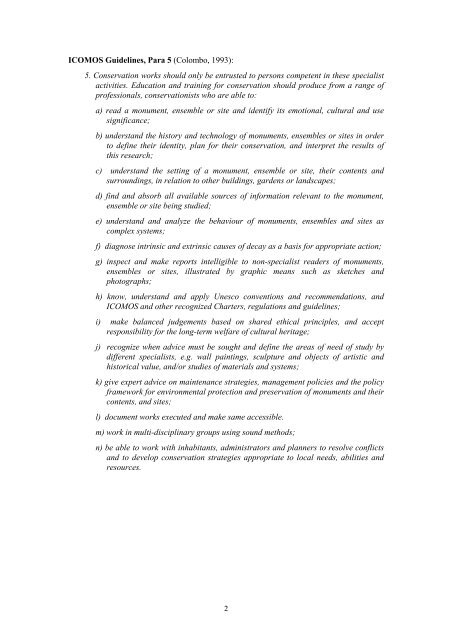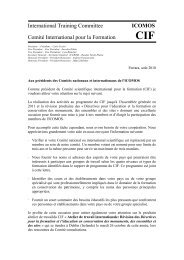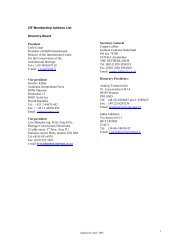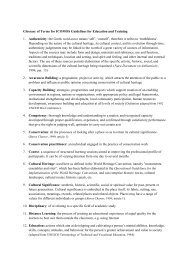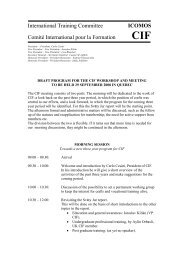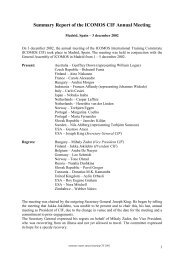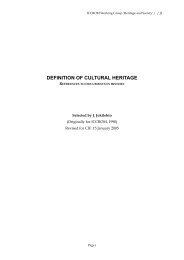COTAC Conference on Training in Architectural Conservation Multi ...
COTAC Conference on Training in Architectural Conservation Multi ...
COTAC Conference on Training in Architectural Conservation Multi ...
Create successful ePaper yourself
Turn your PDF publications into a flip-book with our unique Google optimized e-Paper software.
ICOMOS Guidel<strong>in</strong>es, Para 5 (Colombo, 1993):<br />
5. C<strong>on</strong>servati<strong>on</strong> works should <strong>on</strong>ly be entrusted to pers<strong>on</strong>s competent <strong>in</strong> these specialist<br />
activities. Educati<strong>on</strong> and tra<strong>in</strong><strong>in</strong>g for c<strong>on</strong>servati<strong>on</strong> should produce from a range of<br />
professi<strong>on</strong>als, c<strong>on</strong>servati<strong>on</strong>ists who are able to:<br />
a) read a m<strong>on</strong>ument, ensemble or site and identify its emoti<strong>on</strong>al, cultural and use<br />
significance;<br />
b) understand the history and technology of m<strong>on</strong>uments, ensembles or sites <strong>in</strong> order<br />
to def<strong>in</strong>e their identity, plan for their c<strong>on</strong>servati<strong>on</strong>, and <strong>in</strong>terpret the results of<br />
this research;<br />
c) understand the sett<strong>in</strong>g of a m<strong>on</strong>ument, ensemble or site, their c<strong>on</strong>tents and<br />
surround<strong>in</strong>gs, <strong>in</strong> relati<strong>on</strong> to other build<strong>in</strong>gs, gardens or landscapes;<br />
d) f<strong>in</strong>d and absorb all available sources of <strong>in</strong>formati<strong>on</strong> relevant to the m<strong>on</strong>ument,<br />
ensemble or site be<strong>in</strong>g studied;<br />
e) understand and analyze the behaviour of m<strong>on</strong>uments, ensembles and sites as<br />
complex systems;<br />
f) diagnose <strong>in</strong>tr<strong>in</strong>sic and extr<strong>in</strong>sic causes of decay as a basis for appropriate acti<strong>on</strong>;<br />
g) <strong>in</strong>spect and make reports <strong>in</strong>telligible to n<strong>on</strong>-specialist readers of m<strong>on</strong>uments,<br />
ensembles or sites, illustrated by graphic means such as sketches and<br />
photographs;<br />
h) know, understand and apply Unesco c<strong>on</strong>venti<strong>on</strong>s and recommendati<strong>on</strong>s, and<br />
ICOMOS and other recognized Charters, regulati<strong>on</strong>s and guidel<strong>in</strong>es;<br />
i) make balanced judgements based <strong>on</strong> shared ethical pr<strong>in</strong>ciples, and accept<br />
resp<strong>on</strong>sibility for the l<strong>on</strong>g-term welfare of cultural heritage;<br />
j) recognize when advice must be sought and def<strong>in</strong>e the areas of need of study by<br />
different specialists, e.g. wall pa<strong>in</strong>t<strong>in</strong>gs, sculpture and objects of artistic and<br />
historical value, and/or studies of materials and systems;<br />
k) give expert advice <strong>on</strong> ma<strong>in</strong>tenance strategies, management policies and the policy<br />
framework for envir<strong>on</strong>mental protecti<strong>on</strong> and preservati<strong>on</strong> of m<strong>on</strong>uments and their<br />
c<strong>on</strong>tents, and sites;<br />
l) document works executed and make same accessible.<br />
m) work <strong>in</strong> multi-discipl<strong>in</strong>ary groups us<strong>in</strong>g sound methods;<br />
n) be able to work with <strong>in</strong>habitants, adm<strong>in</strong>istrators and planners to resolve c<strong>on</strong>flicts<br />
and to develop c<strong>on</strong>servati<strong>on</strong> strategies appropriate to local needs, abilities and<br />
resources.<br />
2


